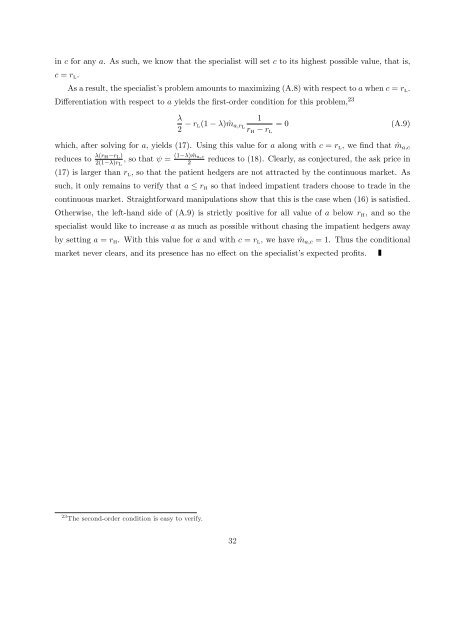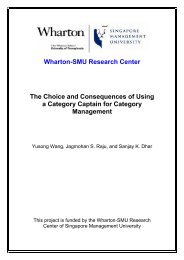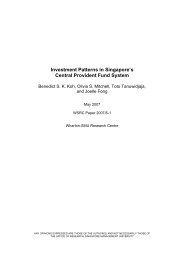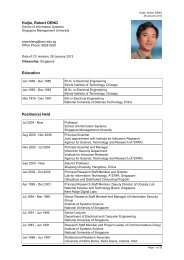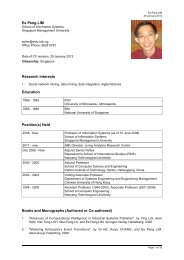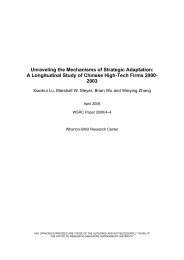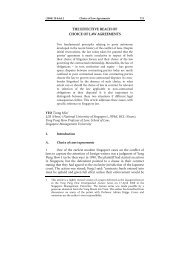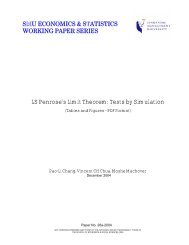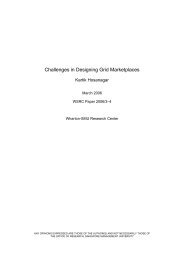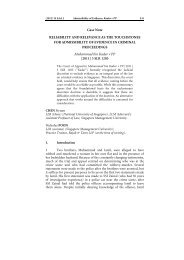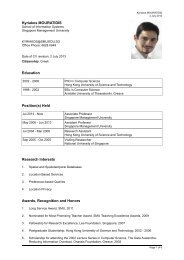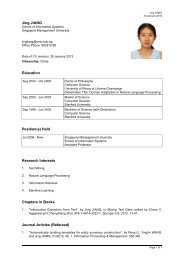in c for any a. As such, we know that the specialist will set c to its highest possible value, that is, c = r L. As a result, the specialist’s problem amounts to maximizing (A.8) with respect to a when c = r L. Differentiation with respect to a yields the first-order condition for this problem, 23 λ 2 − r 1 L(1 − λ) ˆma,rL = 0 (A.9) rH − rL which, after solving for a, yields (17). Using this value for a along with c = rL, we find that ˆma,c reduces to λ(rH−rL) (1−λ) ˆma,c , so that ψ = 2(1−λ)rL 2 reduces to (18). Clearly, as conjectured, the ask price in (17) is larger than rL, so that the patient hedgers are not attracted by the continuous market. As such, it only remains to verify that a ≤ r H so that indeed impatient traders choose to trade in the continuous market. Straightforward manipulations show that this is the case when (16) is satisfied. Otherwise, the left-hand side <strong>of</strong> (A.9) is strictly positive for all value <strong>of</strong> a below r H, and so the specialist would like to increase a as much as possible without chasing the impatient hedgers away by setting a = r H. With this value for a and with c = r L, we have ˆma,c = 1. Thus the conditional market never clears, and its presence has no effect on the specialist’s expected pr<strong>of</strong>its. 23 <strong>The</strong> second-order condition is easy to verify. 32
References Amihud, Y., and H. Mendelson, 1980, “Dealership Market: Market-Making with Inventory,” Jour- nal <strong>of</strong> Financial Economics, 8, 31-53. Bagehot, W., 1971, “<strong>The</strong> Only Game in Town,” Financial Analysts Journal, 27, 12-14/22. Barclay, M. J., and T. Hendershott, 2003, “Price Discovery and Trading After Hours,” Review <strong>of</strong> Financial Studies, 16, 1041-1073. Barclay, M. J., and T. Hendershott, 2004, “Liquidity Externalities and Adverse Selection: Evidence from Trading After Hours,” Journal <strong>of</strong> Finance, 59, 681-710. Barclay, M. J., T. Hendershott, and D. T. McCormick, 2003, “Competition Among Trading Venues: Information and Trading on Electronic Communications Networks,” Journal <strong>of</strong> Finance, 58, 2637- 2665. Battalio, R. H., 1997, “Third Market Broker-Dealers: Cost Competitors or Cream Skimmers?,” Journal <strong>of</strong> Finance, 52, 341-352. Bessembinder, H., and K. Venkataraman, 2004, Does an Electronic Stock Exchange Need an Up- stairs Market?” Journal <strong>of</strong> Financial Economics, 73, 3-36. Bhattacharya, U., and M. Spiegel, 1991, “Insiders, Outsiders, and Market Breakdowns Journal,” Review <strong>of</strong> Financial Studies, 4, 255-282. Biais, B., 1993, “Price Formation and Equilibrium Liquidity in Fragmented and Centralized Mar- kets,” Journal <strong>of</strong> Finance, 48, 157-185. Biais, B., T. Foucault, and F. Salanié, 1998, “Floors, Dealer Markets and Limit <strong>Order</strong> Markets,” Journal <strong>of</strong> Financial Markets, 1, 253-284. Booth, G. G., J.-C. Lin, T. Martikainen, and Y. Tse, 2002, “Trading and Pricing in Upstairs and Downstairs Stock Markets,” Review <strong>of</strong> Financial Studies, 15, 1111-1135. Chordia, T., and A. Subrahmanyam, 1995, “Market Making, the Tick Size, and Payment-for-<strong>Order</strong> Flow: <strong>The</strong>ory and Evidence,” Journal <strong>of</strong> Business, 68, 543-575. Chowdhry, B., and V. Nanda, 1991, “Multimarket Trading and Market Liquidity,” Review <strong>of</strong> Financial Studies, 4, 483-511. 33
- Page 1 and 2: The Benefits of Volume-Conditional
- Page 3 and 4: The Benefits of Volume-Conditional
- Page 5 and 6: 1 Introduction Traders have various
- Page 7 and 8: time they place their order, for th
- Page 9 and 10: off. Interestingly, the models do g
- Page 11 and 12: market-making is competitive, but w
- Page 13 and 14: or do not wish to monitor. 6 Our mo
- Page 15 and 16: informed speculators to the model i
- Page 17 and 18: The proof of Proposition 3.2 shows
- Page 19 and 20: 4 Informed Traders 4.1 Introducing
- Page 21 and 22: fixed: as before, their position is
- Page 23 and 24: elative imbalance between buy and s
- Page 25 and 26: tional market and the continuous ma
- Page 27 and 28: example, like them, it relies exclu
- Page 29 and 30: The last part of the proposition, t
- Page 31 and 32: Thus impatient traders do not devia
- Page 33 and 34: This condition is implied by (15).
- Page 35: Also, because their expected utilit
- Page 39: Madhavan, A., 2000, “Market Micro


